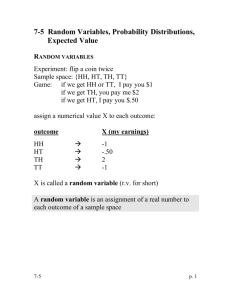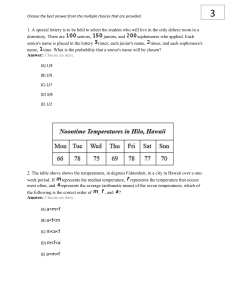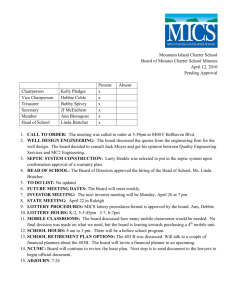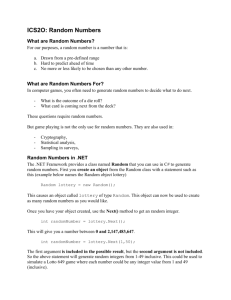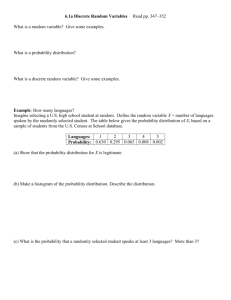Section 4 1
advertisement
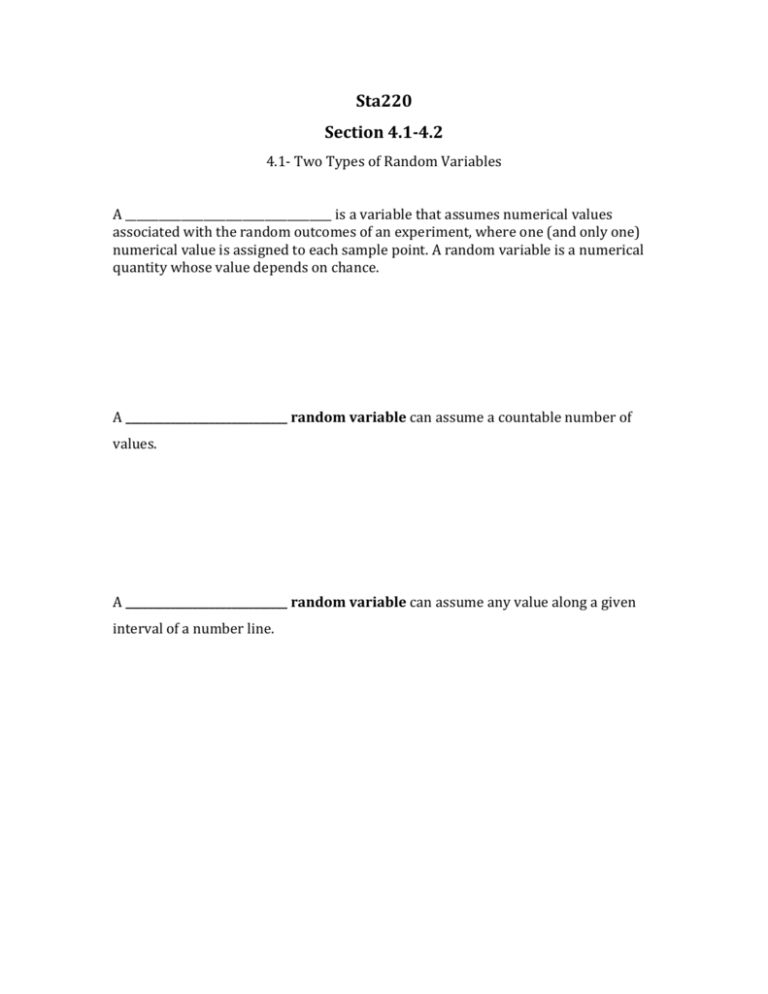
Sta220 Section 4.1-4.2 4.1- Two Types of Random Variables A _____________________________________ is a variable that assumes numerical values associated with the random outcomes of an experiment, where one (and only one) numerical value is assigned to each sample point. A random variable is a numerical quantity whose value depends on chance. A _____________________________ random variable can assume a countable number of values. A _____________________________ random variable can assume any value along a given interval of a number line. 4.2 – Probability Distributions for Discrete Random Variables The ______________________________________ of a discrete random variable is a graph, table, or formula that specifies the probability associated with each possible value the random variable can assume. Requirements for Probability Distribution of a Discrete Random Variable x 1. 2. where the summation of p(x) is over all possible values of x. Example: Toss 2 coins. Count number of tails. Expected value of a random variable ______________________ (Mean of probability distribution) Weighted average of all possible values 𝜇= Example Example: Suppose you work for an insurance company and you sell a $10,000 one-year term insurance policy at an annual premium of $290. Actuary tables show that the probability of death during the next year for a person of you customer's age, sex, health, etc., is 0.001. What is the expected gain (amount of money made by the company) for a policy of this type? Gain x Sample Probability Point Example: The Lottery A certain lottery works by picking 6 numbers from 1 to 49. It costs $1.00 to play the lottery, and if you win, you win $2 million after taxes. If you play the lottery once, what are your expected winnings or losses? Then, if you play the lottery every week for 10 years, what are your expected winnings or losses? ____________________ of a random variable x is. Weighted average of squared deviation about mean 𝜎 2 = 𝐸[(𝑥 − 𝜇)2 ] = ∑(𝑥 − 𝜇)2 𝑝(𝑥) The _____________________________________ of a discrete random variable is equal to the square root of the variance, 𝜎= Example A roulette wheel has the numbers 1 through 36, as well as 0 and 00. If you bet $1 that an odd number comes up, you win or lose $1 according to whether or not that event occurs. If random variable X denotes your net gain, X=1 with probability 18/38 and X= -1 with probability 20/38. A. What is μ = E(x)? Interpret the results. B. What would μ be if you bet $10 a game? How much would the casinos make if 10,000 of these games were played? C. We already calculated 𝜇= -$.053. What is σ? Interpret the result. Example Medical research has shown that a certain type of chemotherapy is successful 70% of the time when used to treat skin cancer. Suppose five skin cancer patients are treated with this type of chemotherapy, and let x equal the number of successful cures out of the five. The probability distribution for the number x of successful cures out of five is given in the following table: x 0 1 2 3 4 5 p(x) .002 .029 .132 .309 .360 .168 a. Find 𝜇. Interpret the results. b. Find 𝜎. Interpret the result. c. Graph p(x). Locate 𝜇 and the interval 𝜇 ± 2𝜎 on the graph. Use either Chebyshev’s rule or the empirical rule to approximate the probability that x falls into the interval. Compare your result with the actual probability. d. Would you expect to observe fewer than two successful cures out of five?

